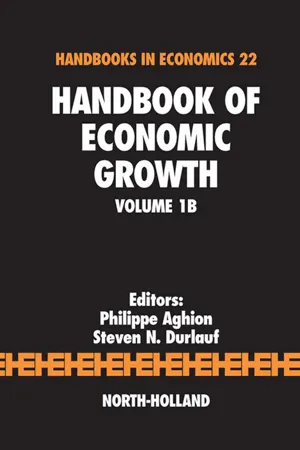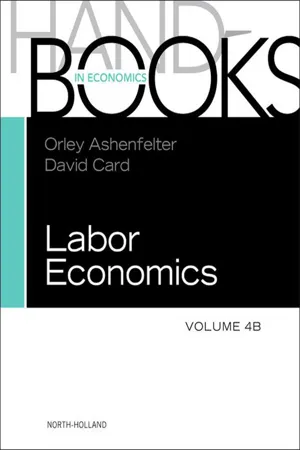Economics
Skill Biased Technological change
Skill-biased technological change refers to the phenomenon where technological advancements disproportionately benefit individuals with higher skill levels, leading to increased demand for skilled workers and higher wages for those workers. This can result in greater income inequality as the gap between skilled and unskilled workers widens.
Written by Perlego with AI-assistance
Related key terms
3 Key excerpts on "Skill Biased Technological change"
- eBook - ePub
The Way Back
Restoring the Promise of America
- F. H. Buckley(Author)
- 2017(Publication Date)
- Encounter Books(Publisher)
Since technological change seems so apparent, SBTC explanations won ready acceptance. Technology-based theories rest on three assumptions, however. First, if there’s been technological change, is it really “skill-based”? That is, does technology on net transfer jobs to the highly skilled as opposed to the low-skilled? The answer, very likely, is yes, but the other two assumptions are more questionable. Is our sense of technological change an illusion? Is there really more of it today than 100 years ago? If not, SBTC theories can’t begin to explain the recent run-up in inequality. Lastly, SBTC explanations assume that the demand for high-skilled jobs has increased and outpaced the supply of high-skilled workers, driving up their wages. Perhaps it’s the other way around, however. Perhaps we’ve seen a relatively smaller supply of high-skilled workers chasing the high-tech jobs. That would also drive up their wages, and if so the rise in inequality might have little to do with technological change.Is Technological Change Skill-based?Has technological change advantaged the highly skilled more than the low-skilled? Perhaps not. First, the highly skilled might have been paid more even in a low-tech world. Before there were computers and business software programs, there were office managers, accountants, bookkeepers, and secretaries who served as their firm’s memory and information processors. They had to be smart to do their jobs and were better paid to do so. If the highly skilled commanded a wage premium 100 years ago, technological innovations since then might not have changed the relative wage premium they receive today. They were paid more before and they’re paid more now.The second reason why technological change might not be skill-based is because new technologies can benefit low-tech as well as high-tech workers. In the nineteenth century, the steel plow—the Plow that Broke the Plains—allowed farmers to transform an ocean of prairie grasslands to arable farmland in a generation. And not very long ago, George H. Bush was intrigued to learn that a poorly educated sales clerk could price a can of beans simply by scanning a bar code.To see how new technology can assist even the humblest of low-tech workers, take the deliveryman going about his rounds. Let’s say that he has to visit six different houses, and that it doesn’t matter in which order he does so. What he faces is called the Fuller Brush Salesman problem, from back when brushes were peddled door to door. With six houses, the deliveryman has to choose amongst six-factorial (6 * 5 * 4 * 3 * 2) or 720 possible routes. Some are longer than others, and how is he going to know the shortest one? True, there aren’t many door-to-door travelling salesmen today, but there are UPS drivers and they have the same problem. Each UPS truck makes around 130 stops per day, and for each mile the trucks cut from their routes the company saves $30 million a year.2 - eBook - ePub
- Philippe Aghion, Steven Durlauf(Authors)
- 2005(Publication Date)
- North Holland(Publisher)
However, it is an open question to what extent the observed changes in returns were predicted by the cohorts affected by these returns when they made their education decisions. 38 Models of directed technical change, augmented by an endogenous supply of skills, can give rise to multiple steady states. If the innovators expect the supply of educated workers to rise, they will invest in skill-biased R&D which, in turn, will augment the returns to college and induce households to acquire human capital, fulfilling the innovators' expectations. 3.3.1 Sources of the skill-bias in recent times Equation (14) shows that the most natural candidate as engine of the recent skill-biased technical change was the rise in the relative supply of educated workers. The latter was, according to Acemoglu (2002a) largely exogenous, at least initially, and a result of the high college enrollment rates of the baby-boom cohort and of the Vietnam war draft. The crucial issue, still unresolved, is whether the necessary parametric restrictions discussed earlier are plausible, and whether the initial shock is large enough. 39 What other changes in the economic environment can be listed as potential sources of skill-biased innovations? First, there are possible interactions between capital-skill complementarity and the direction of technical change. Hornstein and Krusell (2003) have taken a first step at incorporating the idea of factor-biased innovations into the KORV explanation of the skill premium. Intuitively, an acceleration in capital accumulation due, for example, to an exogenous fall in the price of capital increases the returns to skill-biased innovations if capital is more complementary with skilled labor. Hence, capital-embodied productivity improvements can be the source of factor-biased technical progress - eBook - ePub
- Orley Ashenfelter, David Card(Authors)
- 2010(Publication Date)
- North Holland(Publisher)
5 ) expanding offshoring in opportunities, enabled by technology, which allow foreign labor to substitute for domestic workers specific tasks. Motivated by these patterns, we argue that it is valuable to consider a richer framework for analyzing how recent changes in the earnings and employment distribution in the United States and other advanced economies are shaped by the interactions among worker skills, job tasks, evolving technologies, and shifting trading opportunities. We propose a tractable task-based model in which the assignment of skills to tasks is endogenous and technical change may involve the substitution of machines for certain tasks previously performed by labor. We further consider how the evolution of technology in this task-based setting may be endogenized. We show how such a framework can be used to interpret several central recent trends, and we also suggest further directions for empirical exploration.Keywords
College premium; Directed technical change; Earnings inequality; Occupations; Returns to schooling; Skill biased technical change; Skill premium; Tasks; Wage inequalityJEL classification: J20; J23; J24; J30; J31; O31; O331. Introduction
The changes in the distribution of earnings and the returns to college over the last several decades in the US labor market have motivated a large literature investigating the relationship between technical change and wages. The starting point of this literature is the observation that the return to skills, for example as measured by the relative wages of college graduate workers to high school graduates, has shown a tendency to increase over multiple decades despite the large secular increase in the relative supply of college educated workers. This suggests that concurrent with the increase in the supply of skills, there has been an increase in the (relative) demand for skills. Following Tinbergen’s pioneering (1974; 1975) work, the relative demand for skills is then linked to technology, and in particular to the skill bias of
Index pages curate the most relevant extracts from our library of academic textbooks. They’ve been created using an in-house natural language model (NLM), each adding context and meaning to key research topics.


